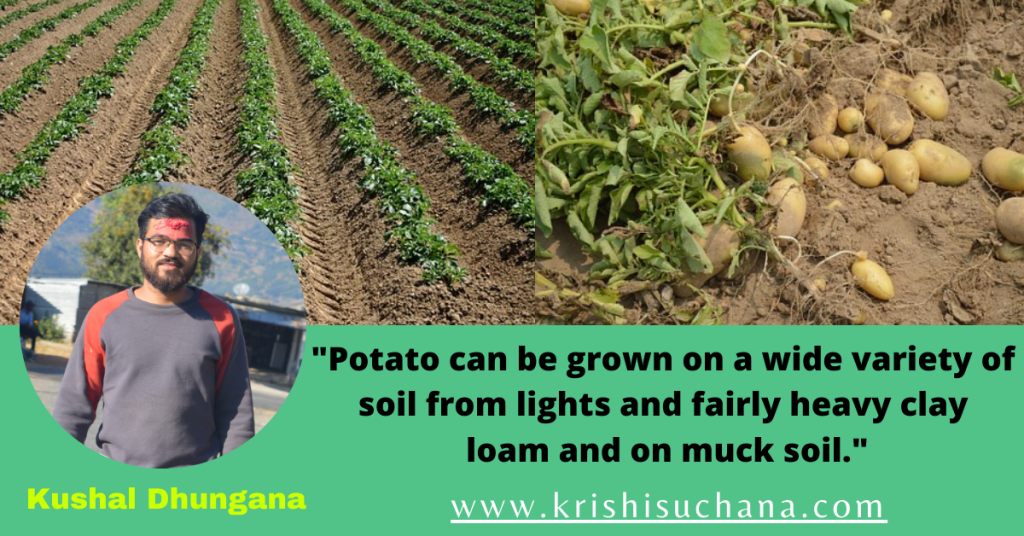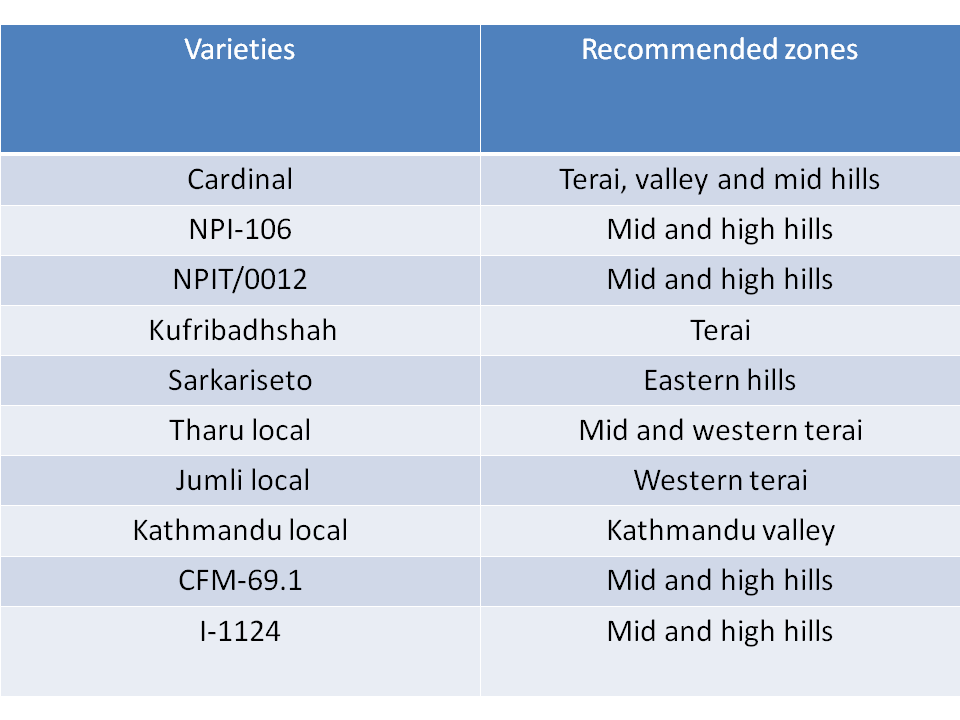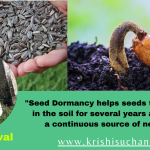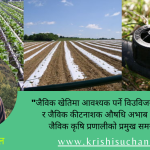Cultivation Practices of Potato in Nepal

Introduction:
Potato, the tuber crop is the major field crop that rank first in terms of productivity and fourth in terms of production areas. It occupies more than 80% of the cultivated area in Europe and other areas and fulfills the food requirement by 50- 60 %.
Importance:
From the nutritional point of view, potato is the best source of food. It contains high amount of starch, protein (2%), fat (0.1%) and carbohydrate (19.4%). In comparison to cereal crops, starch and protein in potato has high digestibility. It has high biological value that is 98 in comparison to 82 in wheat and rice respectively.
Except Vit-A &Vit-E, it contains Vit-B6 & Vit-C in adequate amount. Besides, it contains minerals (Fe, Ca, P, Mg, and S). According to British Association Certification, consumption of 125-150gm of potato daily fulfills the need of vitamins.
Besides, consumption of potato is advantageous to blood pressure, anemia, gastritis etc.
Potato is the native of South America and was cultivated by Incas. It was introduced into Europe by the early Spanish explorers during sixteenth century.
Climatic requirements:
Potato is cool season crop but is only moderately tolerant to frost. Temperature during the growing season has great influence in the yield. Generally, for germination 8Oc is ideal. At very low temperature, growth and development is checked. Day temperature of 30-350C and night temperature of 20-250C is ideal for proper growth and for tuberation 18-200C is ideal. High night temperature is hazardous & sometimes if temperature is above 290C tubers are not formed.
Soil and soil preparation:
Potato can be grown on a wide variety of soil from lights and fairly heavy clay loam and on muck soil. But soil with good aeration drained light textured minerals soil reaction from pH 5-7 is ideal.
Soil ploughing and preparation depends upon, soil type, climate, ploughing instruments, virgin or cultivated land etc. but for effective growth and development, physical structure of soil as well as weeds, stubbles, sterilization of soil should be done. Soil preparation generally can be divided into two parts. First 20-25 cm deep ploughing followed by second ploughing is generally practised. Furrow and ridges are made as per recommended spacing.
Planting:
A. Seed rate and spacing:
With line to line to line spacing of 70 cm and plant to plant spacing 23 cm and with 40 gm. per seed with 4 buds, 2.5 tons seed is required for one hectare in order to maintain ideal plant population and higher yield.
B. Planting season:
Area
Planting season
Harvesting season
Plain (300m)
Bhadra – mangsir
Mangsir- falgun
Poush-falgun
Baisakh – jestha
Fertilizers requirements:
Potato is usually heavily fertilized since they have a high nutrient requirements and high gross value per area which makes heavily fertilization. 30 tons of production removes 150 kg N, 60 kg P & 250 kg K, 90 kg CaO, 30 kg MgO.
Fertilizers application depends upon soil type, soil fertility, temperature, crop rotation, irrigation facilities. In general, 20-30 tons FYM, 150-200 kg N, 75-100 kg P, 150-175kg K is recommended.
Time of application:
Full dose of FYM, phosphorous, potassium and half dose of nitrogen at the time of field preparation and remaining half dose of nitrogen at earthing time by side line or point dressing.
Irrigation:
Pre sowing or pre emergence irrigation than after second irrigation after 30 days and next irrigation as per necessary.
Moisture availability should be adequate for proper growth and development of tuber and sprouting. Low moisture content results for tuberation, poor quality tuber and poor germination. Production of 1 kg of potato required 300-636kg of water and more.
Inter- cultural practices:
A. Weed managements:
Weed control practice is prime necessary in order to reduce loss due to weeds as weeds compete with the potato. At early stage of growth when the is small, weed problem severe, so, 1 hand weeding and hoeing when plant is 10-15 cm. then small growing weeds are controlled at the time of earthing. Then after the plant can cover the weeds and disorganized the effects of weeds. If necessary, next hand weeding can be done.
Chemically, weeds can be control by the application of lasso @ 3 ltr/hac as pre- emergence or post-emergence or a pre- emergence spray of a dinitro compound + diesel oil in the water or sodiumpentochloropenate +diesel oil in water.
B. Earthing:
In order to protect growing tubers from radiation, hot, insect, late blight etc. Plant is covered with soil to some extent depending upon the depth of sowing or planting. If sown to great depth, size of small ridge is enough. Earthing is done when plant is 15-20cm tall at proper moisture level.
Harvesting:
When the plants are turned yellowish & drying, potato is harvested. Before 7-10 days of harvesting, plants are topped at its base or stopped irrigating before 10-15 days of harvesting which helps to mature the coat of potato. Potato is harvested with the help of khurpi by destroying the ridges side by side.
Yield:
With the modern improved cultivation practices, 350-500 quintals of potatoes can be produced.
Grading:
Rotted & damaged tubers are assorted. According to the market necessity, they are graded. Grading is done according to their size, like big, medium & small. For grading iron mesh wire with varying size are used.
Post-harvest management:
After harvesting & grading, tubers are surface dried & kept in shade in heaps for 10-15 days. If the produce is to be marketed early to take benefit of high market price, it is advisable to harvest potato in stage because of high perishable nature of immature tubers.
Various points for seed plot technique of potato under plains:
In order to obtain healthy & high yielding seeds, we have to focus on the following points:
· Use of healthy & disease free seeds.
· Timely sowing (end of Oct.).
· Use of 3/4th dose of nitrogen.
· Use of the whole tuber seeds.
· Use of insecticides (Rogar).
Critical limit- 20 aphids per 100 compound leaves.
· Hand cutting (3rd week of January).
· 2 weeks onward of hand cutting harvesting is to be done.
· Sorting & tuber treatment (3% Boric acid for 30mins.).
· Bagging & storage.
True potato seeds (TPS):
The non-availability of good quality seed tuber, high seed cost, virus infiltration in seed tubers causing degeneration of seed stocks & problem of long distance transport of seeds from seed producing areas have led to the development of TPS technology of crop production.
Following considerations have to be taken for TPS technology:
· TPS has to be sown in nursery beds to produce seedlings. The best substrate for nursery beds is a mixture of 1:1 FYM & soil.
· TPS germinates well when night temperature drop to about 20oC in the plains & shade is provided over nursery bed areas during day time. In plains the best sowing time is October.
· The seedlings raised in nursery can either be transplanted in field to produce a ware/seed crop alternatively allowed to tuberize in the nursery beds produce small seedling tubers which can be used for field planting next year.
· The method of raising the crop using small seedlings tubers produce in nursery bed is successful in all the potato growing regions of the country.
· The raised seedlings for planting in 1ha, about 100gm TPS is required to be thinly sown in 50sq. meter nursery bed areas at 10cm, into row distance seedlings will be ready for transplanting in field in about 20-25 days of germination.
· For producing seedlings tubers for planting 1ha in the following crop season, 40gm TPS is required to be sown in the nursery at 10cm X 10cm inter & intra row spacing. The haulms may be cut on the dates recommended for the seed crop in the area.
· The ware crop from seedling tubers can be raised following the standard agronomic practices of the area, keeping in view that smaller tubers are to be planted at closer spacing. The suitable inter & intra row spacing are 60cm X 20cm for 20-30mm, 60cm X 15cm for 20-25mm, 60cm X 10cm for 15-20mm & 60cm X 5cm for 15mm sized tubers.
· The field produce can be used as seed for at least for2 seasons in potatoes seed producing areas & for 1 season in other areas.
TPS varieties (white varieties):
· HPS-1/13
· TPS/C-3
· 92-PT-27
Varieties recommended in Nepal:
1. KufriJyoti:
· Medium (110-120 days in hills, 100-110 days in mid hills).
· Resistant to late blight, size large oval shaped, skin white smooth.
· 6 weeks dormancy period.
· Yield 20-25tons/ha
2. KufriSinduri:
· Late (110-130 days), size medium, round shape, skin red smooth
· Dormancy period 8 weeks or more.
· Yield 25-30 tons/ha, moderately resistant to early blight.
3. Dejire:
· Medium sized, shape oval, smooth, red color skin.
· Early (70-90 days), susceptible to blight.
4. JanakDev:
· Medium to large size, color red.
· Medium (100-120 days) can be grown in terai mid hill and high hill.
· Dormancy period 6-8 weeks, yield 23 tons.
5. khumal seto-1:
· Round shape, both small and large size, skin colour white.
· Medium (100-120days), yield 25.1 ton/ha.
· Dormancy period 6-8 days, resistant to viral diseases.
6. khumal rato-2:
· Medium size, round shape, smooth skin, light red colour.
· Yield 20-25 ton/ha, resistant to Y-virus.
· Medium variety (100-120 days).
7. Kufribahar:
Medium maturity, size large, shape round, oval, skin white, susceptible to all major diseases.
Following are some other commercial varieties of potato recommended in Nepal
8. Kufrilalima
9. Kufrichandramukhi
10. Local red round
11. Magnum bonum
12. Up-to-date
13. T-0012
14. NPI-106
15. Cardinal
Recommended varieties in different ecological zones of Nepal:

Diseases:
Fungal diseases:
1. Late blight:
C.O. Phytopthora infestans
Symptoms:
· Appearance of water soaked areas which enlarges rapidly and then turn brown or black as the leaf dies.
· White downy mildew sometimes on the lower side of the leaves.
· The late blight produces a dry rot.
Control:
· Spray Bordeaux mixture at interval of 6-10 days.
· Spray Diathene M-45
· Use resistant varieties.
2. Early blight:
C.O.Altrnaria solani
Symptoms:
Initially brown spots and increase in size with concentric rings.
Control:
Spray Diathane M-45 (0.2%)
3. Stem canker:
C.O. Cerospora solani-tuberosis
Symptoms:
Similar to early blight but white appearance in the spot.
Control:
Spray Diathane M-45 (0.2%)
4. Dry rot:
C.O Fusarium caerulium
Symptoms:
Fungal growth in eyes, lenticels and wounds.
Control:
Prevent the injury and use of free seeds.
Bacterial diseases:
1. C.O. Pseudomonas solanacearum
Symptoms:
· Brown ring is observed in the stem.
· Black appearance of the potato eye.
Control:
Crop rotation in 2-3 years and proper irrigation.
2. Soft rot:
C.O. Erwinia cartovora
Symptoms:
Bacteria enter into the tubers through the lenticels.
Control:
· Proper irrigation.
· Storage after treatment of drugs with exposure to air for an hour.
3. Common scab:
C.O. Streptomyces scabies
Symptoms:
Corky spots vary in size and number from a few small dots to large lesions.
Control:
Disinfect tubers with Agallol-6 or Mercuric fungicides.
Viral diseases:
- Leaf roll: leaf rolls and thickened.
- Mild mosaic: light coloration in leaf vein and mixed with dark green.
- Severe mosaic: stunted growth, uneven appearance of stem and scarp appearance on the leaf.
Insects/pests:
- Cut worms: spray Dursban-20 EC or apply phorate in soil.
- Caterpillar: spray Thiodan or BHC (10%)
- Aphid: spray rogar or malathion.
- Jassids: Spray metasystox (0.8%).
Physiological Disorders:
1) Internal brown spots:
It is characterized by irregular, dry brown spots scattered through the flesh of tuber due to irregular irrigation.
2) Black heart:
When potato are stored high temperature of 35-40oC they develop black heart in which inner tissues break down and become black which may be due to lack of oxygen, accumulation of CO2 and high temperature.
3) Hollow heart:
It is characterized by irregular cavity in the center of tuber. Surrounding the cavity, there is no decay or discoloration. It is produced in large sized tuber variety which can be overcome by closure spacing and avoiding excessive use of fertilizers.
4) Chilling injury:
It is due to storage of tubers for long time at temperature of about 00C. This result in discolor blotches in the flesh of tubers which vary from light reddish brown to dark brown.
Writer: Kushal Dhungana (Bsc Ag IAAS 4th sem, Address : Mangalsen Achham)

 गृहमन्त्री लामिछानेविरुद्धको रिट न्यायाधीशद्वय शर्मा र श्रेष्ठको इजलासमा
गृहमन्त्री लामिछानेविरुद्धको रिट न्यायाधीशद्वय शर्मा र श्रेष्ठको इजलासमा  खेलकुदमन्त्री श्रेष्ठले गरे टीयू क्रिकेट मैदानको निरीक्षण
खेलकुदमन्त्री श्रेष्ठले गरे टीयू क्रिकेट मैदानको निरीक्षण  दिल्लीको होटलमा बसेर क्यानडा र अमेरिकामा मानव तस्करी
दिल्लीको होटलमा बसेर क्यानडा र अमेरिकामा मानव तस्करी  अनलाइन जुवा खेलाएर काभ्रेका अनिलले गरे दुई अर्बको कारोबार
अनलाइन जुवा खेलाएर काभ्रेका अनिलले गरे दुई अर्बको कारोबार  मुख्यमन्त्री सोडारीले विश्वासको मत लिन सुदूरपश्चिमको प्रदेश सभा बैठक आव्हान
मुख्यमन्त्री सोडारीले विश्वासको मत लिन सुदूरपश्चिमको प्रदेश सभा बैठक आव्हान 


